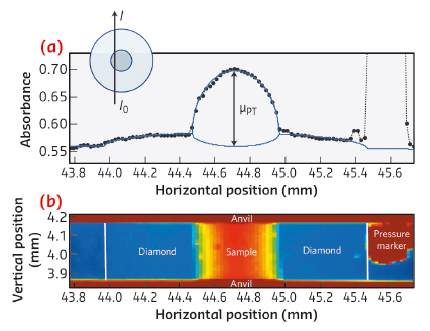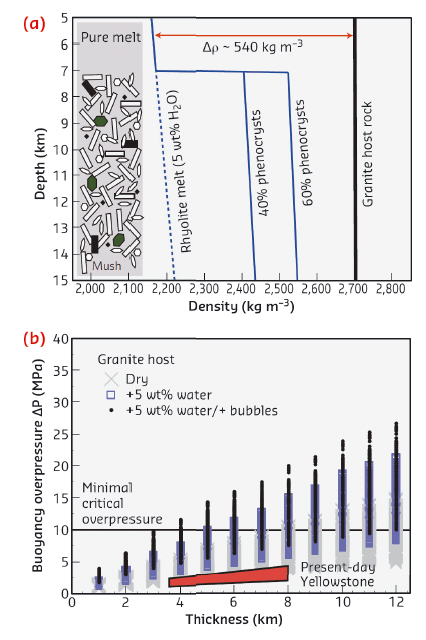- Home
- Users & Science
- Scientific Documentation
- ESRF Highlights
- ESRF Highlights 2014
- Dynamics and extreme conditions
- Buoyant magmas trigger supervolcano eruptions
Buoyant magmas trigger supervolcano eruptions
Supervolcanoes are considered a rare but serious threat due to their destructive capacity only comparable to giant impacts [1]. Well-known supervolcanoes are located in the Yellowstone Caldera (USA), Lake Toba (Indonesia) and Lake Taupo (New Zealand), where the last supereruption occurred 26500 years ago. Supervolcano eruptions are explosive and eject more than 450 km3 (or 1015 kg) of magma (e.g. La Garita, Yellowstone) compared to the mere 10 km3 supplied by the largest conventional volcanic eruptions (e.g., Pinatubo in 1991) [2]. Moreover, supereruptions have a major impact on global climate as the large volumes of emitted ashes and volcanic gasses (e.g. SO2) raise the Earth’s albedo and could decrease the global temperature by up to 10°C for over a decade.
In spite of their devastating impact, the triggering mechanisms for supereruptions have remained elusive until now. Processes occurring in conventional volcanic system are indeed not scalable to the much larger magma chambers beneath supervolcanoes (~ 5-10 km thick and up to 100 km wide). Because supervolcanoes are located in areas with high heat flux, the crust around their magma chambers is relatively hot and ductile. As a result, overpressure due to a change in volume, e.g. by magma recharge, volatile saturation or mush rejuvenation, is dissipated more efficiently in the plastic supervolcano magma chambers than in the more rigid magma chambers of conventional volcanoes [3]. Supervolcanoes therefore do not erupt very often (~1/100000 years on average, [1]).
In an alternative mechanism, magma buoyancy in large magma chambers potentially creates an overpressure sufficient for an eruption [3]. Contrary to the other plausible triggers, the buoyancy overpressure does not decrease upon wall rock deformation and expansion of the magma chamber. However, the viability of this mechanism could not be evaluated until now due to the lack of appropriate density data for the SiO2-rich magmatic liquids that fed supereruptions.
We conducted experiments at beamline ID27 to determine the density of dry and hydrous rhyolitic/granitic liquids (78 wt% SiO2) using a Paris-Edinburgh press and a synchrotron X-ray absorption technique. Finely-powdered synthetic rhyolitic glasses with various H2O contents (0, 4.5 and 7.7 wt% H2O) were loaded into natural diamond cylinders and subjected to pressures (P) and temperatures (T) up to 3.6 GPa and 1950 K. After compression, the samples were heated until complete melting was confirmed by X-ray diffraction. The liquid density was determined in situ from the X-ray absorption contrast between the sample and the diamond cylinder used as container (Figure 90). The experimental densities were implemented in a model for the density of dry and hydrous granitic liquids at crustal and shallow upper mantle conditions (< 100 km depth) that allows the first evaluation of the buoyancy overpressure in supervolcano magma chambers.
 |
|
Fig. 90: a) X-ray absorbance scan through the sample assembly (i.e., cylindrical diamond capsule and sample) as a function of the X-ray beam position in the horizontal direction (in mm) at 1.02 GPa - 1735 K (dotted line). The density (ρPT) is derived from the attenuation coefficient of the sample (μPT), obtained from the fit (blue line) to the measured absorbance profile. The strong absorption near 45.6 mm indicates the position of Pt-bearing pressure-temperature calibrants touching the outside of the diamond capsule. b) X-ray absorbance map of the gap between the anvils, reconstituted from horizontal scans collected at different vertical positions. |
For each melt composition and magma chamber conditions (i.e. thickness, degree of crystallisation and P-T), the density profiles (Figure 91a) and overpressures at the roof of the magma chamber (Figure 91b) were computed with our liquid density model and literature data for relevant mineral and volatile phases. Our results show that for magma chambers thicker than 5 km, if there are no volatiles, the buoyancy overpressure in the roof of the magma chamber is lower than the minimal critical overpressure (10 MPa) required to break the cap rock and to initiate the eruption. Therefore, magma buoyancy provides a background overpressure that can progressively increase by the addition of heat and/or magma during the evolution of a supervolcano and that primes the magma chamber for another (small) trigger or may ultimately lead to a supereruption by itself. The present results thus show that external triggers are not a priori required to start an eruption and that buoyancy alone may trigger a supereruption.
 |
|
Fig. 91: a) Density profiles of a supervolcano magma chamber consisting of a 2 km thick granitic melt layer on top of 8 km of crystal mush (40 or 60% crystallinity) [4] and density contrast (Δρ) with the host rock. b) Buoyancy overpressure as a function of magma chamber thickness for a range of plausible chamber conditions; the red area denotes the overpressure for the present-day magma chamber conditions at Yellowstone (3.6-8 km thick, 68-90% crystallinity). In magma chambers thicker than 5 km, the buoyancy derived overpressure may exceed the critical overpressure (10-40 MPa) required for an eruption, even in the absence of volatile saturation. |
Principal publication and authors
W.J. Malfait (a), R. Seifert (a), S. Petitgirard (b), J.-P. Perrillat (c), M. Mezouar (b), T. Ota (d), E. Nakamura (d), P. Lerch (e) and C. Sanchez-Valle (a), Nature Geosciences 7, 122-125 (2014).
(a) Institute for Geochemistry and Petrology, ETH Zurich (Switzerland)
(b) ESRF
(c) Laboratoire de Géologie de Lyon, Université Claude Bernard Lyon 1 and Ecole Normal Supérieure de Lyon, CNRS UMR 5276, Villeurbanne (France)
(d) Institute for Study of the Earth’s Interior, Okayama University (Japan)
(e) Paul Scherrer Institute, Villigen (Switzerland)
References
[1] S. Self and S. Blake, Elements 4, 41 (2008).
[2] B.G. Mason, D.M. Pyle and C. Oppenheimer, Bull. Volcanol. 66, 735 (2004).
[3] A.M. Jellinek and D.J.A. DePaolo, Bull. Volcanol. 65, 363-381 (2003).
[4] O. Bachmann and G.W. Bergantz, J. Petrol. 45, 1565 (2004).



